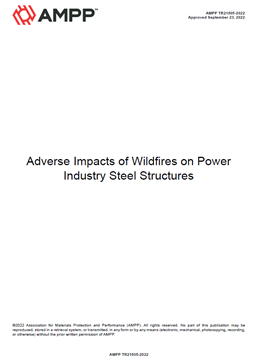Search
Products tagged with 'Standards Benefit For Members'
View as
Sort by
Display
per page
AMPP TR21473-2024, In-Situ Coating of Steel Pipelines via Pigging
Product Number:
AMPP TR21473-2024
Publication Date:
2024
$109.00
AMPP TR21478-2023, 3D Optical Imaging Techniques
Product Number:
AMPP TR21478-2023
Publication Date:
2023
$109.00
AMPP TR21499-2022, Currently Used Procedures for Dry Film Thickness Measurement and Recording for Coatings on Railcars
Product Number:
AMPP TR21499-2022
Publication Date:
2022
$109.00
AMPP TR21500-2022, Surface Preparation by Encapsulated Blast Media for Repair of Existing Coatings on Railcars
Product Number:
AMPP TR21500-2022
Publication Date:
2022
$109.00
AMPP TR21505-2022, Adverse Impacts of Wildfires on Power Industry Steel Structures
Product Number:
AMPP TR21505-2022
Publication Date:
2022
$109.00
AMPP TR21522-2024, Corrosion Testing for Additive Manufacturing
Product Number:
AMPP TR21522-2024
Publication Date:
2024
$109.00
AMPP TR21524-2023, Commentary on Standards Development for Selection and Qualification of HSC-Resistant Materials in Subsea Service with Cathodic Protection
Product Number:
AMPP TR21524-2023
Publication Date:
2023
$109.00
AMPP TR21527-2023, Corrosion and Protection of Tank Cars in Crude Oil Service
Product Number:
AMPP TR21527-2023
Publication Date:
2023
$109.00
AMPP TR21540-2022, Correlating Qualitative Surface Profile Assessment Methods to Quantitative Methodology on Prepared Concrete Substrates
Product Number:
AMPP TR21540-2022
Publication Date:
2022
$109.00
AMPP TR21544-2022, Corrosion and Mitigation Techniques for Fire Protection Piping Systems
Product Number:
AMPP TR21544-2022
Publication Date:
2022
$109.00
ANSI/NACE SP0508-2017, Methods of Validating Equivalence to ISO 8502-9 on Measurement of the Levels of Soluble Salts
Product Number:
21134-SG
ISBN:
1-57590-222-2
Publication Date:
2017
$109.00
ANSI/NACE TM0284-2016, Evaluation of Pipeline and Pressure Vessel Steels for Resistance to Hydrogen-Induced Cracking
Product Number:
21215-SG
ISBN:
1-57590-163-3
Publication Date:
2016
$109.00












